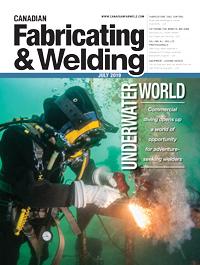Associate Editor
- FMA
- The Fabricator
- FABTECH
- Canadian Metalworking
Diving into underwater welding and burning
Commercial diving opens up a world of opportunity for adventure-seeking welders
- By Lindsay Luminoso
- July 17, 2019
- Article
- Welding
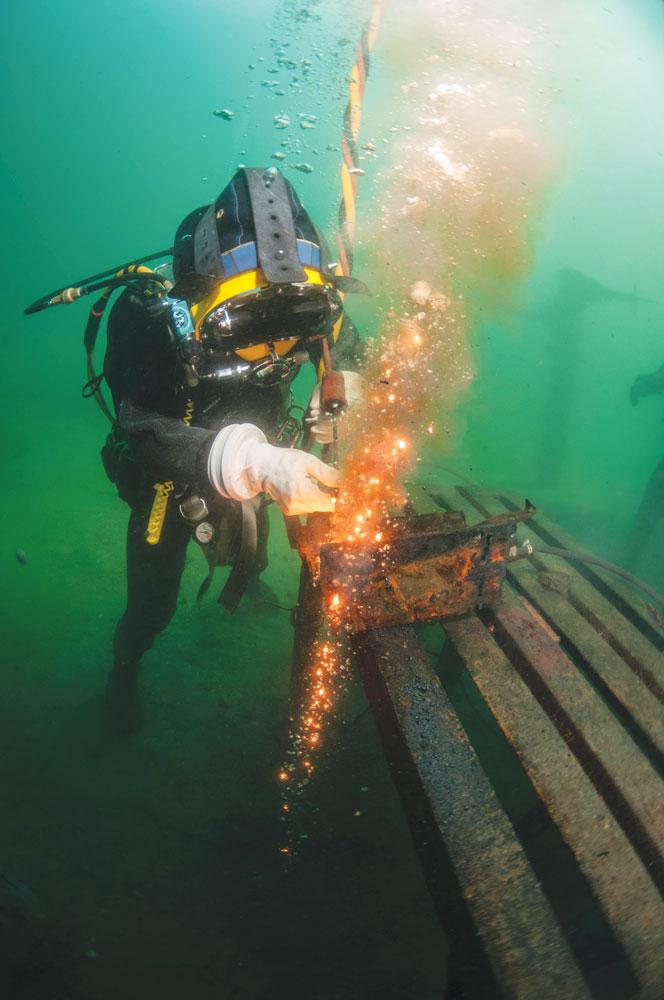
Underwater welding is just one facet of a commercial diver’s job but an important one. Yet, producing sparks and fire underwater requires training and skill.
Have you ever wondered what it takes to become a commercial diver and underwater welder? This challenging and unconventional career path demands commitment both to work ethic and adventure and is certainly not for everyone. But for those who love to travel and are looking for a physical and mental challenge, commercial diving can be a rewarding option.
“As commercial divers, we do a ton of underwater work,” said Kelly Korol, director of training and operations, DiveSafe International, Campbell River, B.C. “We do everything from salvage to construction to pouring cement. We also perform inspection diving and then occasionally we get an opportunity to underwater weld.”
Korol explained that two types of welding are performed underwater: hyperbaric welding and wet welding. In hyperbaric welding, a habitat, airspace, or air pocket is submersed and placed over the area that the diver wants to weld. The diver can then swim into the area and weld much like that of a top-side welder.
“The advantage of hyperbaric welding is that you don’t get very fast quenching on the weld,” said Korol. “This makes the weld strong and as good as you would get in a top-side weld. For something like pressure welding or for fixing a pipeline, underwater structure, or vessel hull, this is the best way to do it.”
However, in dire circumstances or in a pinch, wet welding is another option. Korol noted that the challenge with this type of underwater welding is that the weld area quenches very quickly so the metal can become extremely brittle and there can be problems with porosity and contaminants getting into the weld.
“It’s a great option if we need to go down and patch something,” said Korol. “In Canada a diving company can get a call out to weld a patch on a vessel that has run aground. There is a hole in the hull and we have to put a patch over it and stitch that patch up along the sides, making it good enough to get the vessel to dry dock. At that point the underwater path will be removed and it will be properly fixed and welded.”
Beyond these applications, Korol added that he also sees a lot of work in which a diver welds zincs onto a structure like a barge or bridge footings where there is a critical issue. A sacrificial anode is welded on that will eventually dissolve into the water
“It’s a good way to protect metal structures and foundations,” said Korol. “We often dive down and weld these sacrificial anodes onto the structure, whatever it may be, and it acts like a really good tack weld. The weld is good enough to allow the electrical conduct for the zinc to work well, but it wouldn’t be a structural type of weld.”
Commercial Diving Training
Underwater welding is only a small part of what a commercial diver does, and some commercial divers may never have the opportunity to perform this task. However, all divers training for their unrestricted surface supply level certification are required to be trained in underwater welding. Regardless, Korol noted that he likes to focus on top-side welding skills.
“One thing that I have noticed over the years is that it is much easier to train a welder how to dive than it is to train a diver how to weld well,” said Korol. “Welding is really an art, and it takes a lot of hours and practice to master it.”

It is important for DiveSafe International that its students get real-world experience in their training, particularly in seamanship and ocean skills.
The basic training courses are designed to cover rudimentary skills for basic shielded metal arc welding (SMAW), along with safety elements to avoid electrocution underwater. The Canadian standards stipulate 30 hours of instruction in this area. Generally, the course comprises three to four days of top-side welding and then another three to four days of underwater welding. Korol added that he also covers a fair bit of underwater cutting, usually about two days, using exothermic cutting rods because commercial divers generally will do 10 times more cutting underwater than they will welding.
Having top-side welding experience is an asset for anyone interested in going into commercial diving, and not only for better underwater welding skills.
“When I was working in the water, we came across a lot of top-side welding,” he said. “For example, if we had to lower a sea container or compressor onto a barge, we would want to weld it to the deck so it wouldn’t move around. So for the most part, we use a lot of our skills top-side welding. Underwater welding is not a huge part of the industry in Canada, but as commercial divers, we need to be jack-of-all-trades people.”
Underwater Welding Techniques
When it comes to underwater welding, Korol explained that divers don’t require the same skills and precision as top-side welders. The basic welding process used is SMAW (or stick) because that is the only process that really works underwater.
“We can’t use MIG or TIG welding, so stick welding is the way to go,” said Korol. “However, when we are underwater welding we always use direct current with a positive ground.”
Korol explained that the electrons flow from the diver’s stinger directly through the work to the ground clamp and then the diver is out of the circuit. DC positive ground is the best way to protect divers from electrocution underwater.
“We have a couple of rules that we always have to remember,” said Korol. “One is PIG, which stands for ‘Positive is ground.’ We teach our divers the correct polarity for wet welding. And the other is that we never turn our back on a ground clamp.”
Korol cautioned that if a diver is holding the stinger and turns his back on the ground clamp, he is putting himself into the circuit, and if that circuit is hot, he could be electrocuted. The other rule that Korol always follows is never to use alternating current. He explained that AC can go in all kinds of different directions and potentially electrocute the diver, which is why he always uses DC.
Beyond that, Korol said that the training is fairly basic for stick welding. The only real difference is that a diver needs to prevent the flux from blowing off the rod while underwater.
The rod usually is dipped in a varnish or coating that will protect and waterproof it, at least for a short amount of time. Once a rod has been used underwater and it won’t be used again for some time, he throws it away because it will go bad.
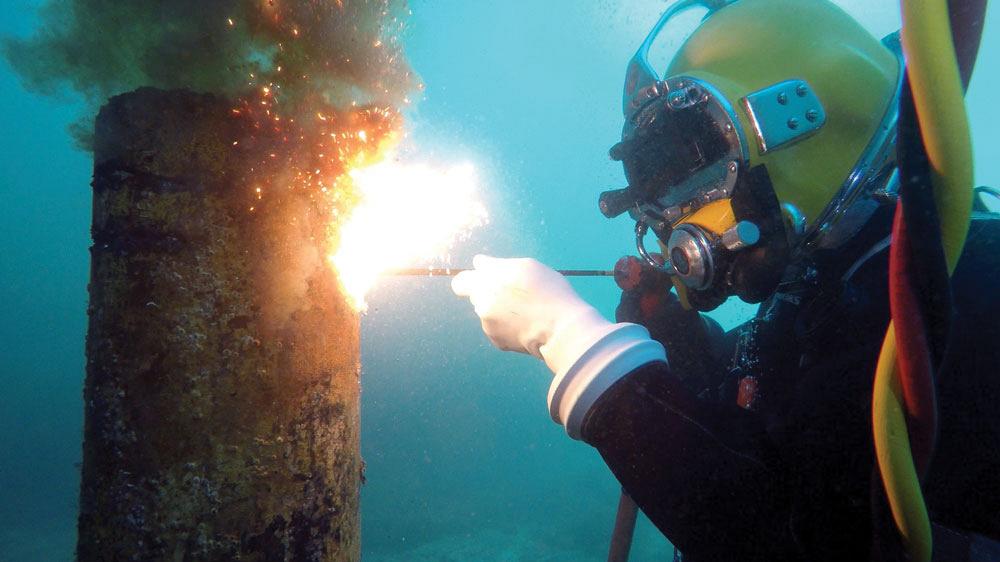
Commercial divers generally will do 10 times more cutting underwater than they will welding, which is why the course covers a fair bit of underwater burning or cutting using exothermic cutting rods.
As the director of training at one of the nation’s largest commercial diving schools, it is important for Korol to ensure that students are getting real-world experience in their training, particularly in seamanship and ocean skills.
One question that he gets asked frequently is whether it is safer to underwater weld in salt or fresh water. Many new students believe that fresh water is the safer option because it doesn’t conduct electricity. However, divers are actually safer in salt water because they always use DC machines. The direct current always tries to go through the salt water before a diver’s body because the water is saltier.
“In fresh water, electricity will see a diver’s body as a good conductor,” said Korol. “This makes it a bit more dangerous than salt water. However, following proper training and welding techniques mitigates the dangers.”
What to Expect
When a diver enters the water, he or she is required to use a surface supply of air rather than a scuba tank. With a surface supply diving apparatus, the team is in full communication with the diver. The ground crew can hear and speak with the diver and control aspects of the equipment. It also provides head protection and unlimited air for breathing.
“All the diver has to focus on is the task at hand,” said Korol. “To weld, all we have to do is bring along a DC welding machine, like a portable, gas-operated one for smaller jobs, and enough welding lead to get the diver down to the worksite.”
He added that one of the important items in the system is a knife switch in line that comes off the welding machine on the negative side. This knife switch allows for the ground crew to control the rack, which is an air manifold that controls air to the diver for breathing and communication. While the diver is heading down to the site, the knife switch is open, meaning the circuit is dead.
When he is ready to weld, all he has to do is call up to the ground crew, who will close the knife switch, allowing the welding process to begin. When he is finished, he lets the ground crew know, and they open the switch. This is a great safety mechanism when a welder needs to change rods or is repositioning work.
“When it comes to commercial diving, we have to be specialists in a number of areas, and rigging is one of them,” said Korol. “We also do a lot of inspection. Underwater welding is just one facet of the job, and it’s an important one. I mean, it is certainly a more exciting part of the job—being able to have sparks and fire underwater.
However, there is not a ton of underwater welding work in the world, and it’s not consistent.”
Korol encourages all of the students to attend local community colleges and take a top-side welding and cutting course. Anyone interested in getting into commercial diving should have a good working knowledge of electricity; small engines, particularly in repairing compressors and generators; and rigging. Safety, including advanced levels of first aid, is always a good one as well.
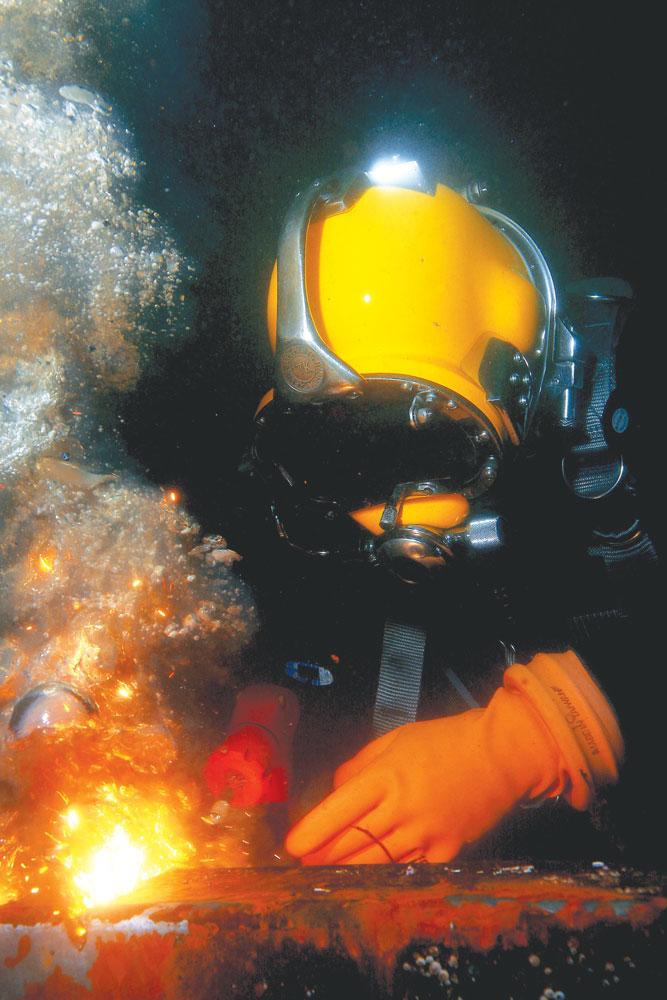
“One thing that I have noticed over the years is that it is much easier to train a welder how to dive than it is to train a diver how to weld well,” said Korol. “Welding is really an art, and it takes a lot of hours and practice to master it.”
Associate Editor Lindsay Luminoso can be reached at lluminoso@canadianfabweld.com.
Photos courtesy of DiveSafe International and DIVESAFE instructor Maxwel Hohn.
About the Author

Lindsay Luminoso
1154 Warden Avenue
Toronto, M1R 0A1 Canada
Lindsay Luminoso, associate editor, contributes to both Canadian Metalworking and Canadian Fabricating & Welding. She worked as an associate editor/web editor, at Canadian Metalworking from 2014-2016 and was most recently an associate editor at Design Engineering.
Luminoso has a bachelor of arts from Carleton University, a bachelor of education from Ottawa University, and a graduate certificate in book, magazine, and digital publishing from Centennial College.
subscribe now


Keep up to date with the latest news, events, and technology for all things metal from our pair of monthly magazines written specifically for Canadian manufacturers!
Start Your Free Subscription- Trending Articles
FMA Annual Meeting: Ingenuity still key with tech innovations

Messer Canada hosts anniversary event

Welding jacket designed for protection, comfort

Compact swing chamber shot blast machine features robotic workpiece handling
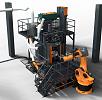
Gang punching press system accommodates different parts quickly

- Industry Events
MME Saskatoon
- May 28, 2024
- Saskatoon, SK Canada
CME's Health & Safety Symposium for Manufacturers
- May 29, 2024
- Mississauga, ON Canada
DiPaolo Machine Tools Open House 2024
- June 4 - 5, 2024
- Mississauga, ON Canada
FABTECH Canada
- June 11 - 13, 2024
- Toronto, ON Canada
Zoller Open House & Technology Days 2024
- June 12 - 13, 2024
- Ann Arbor, MI













